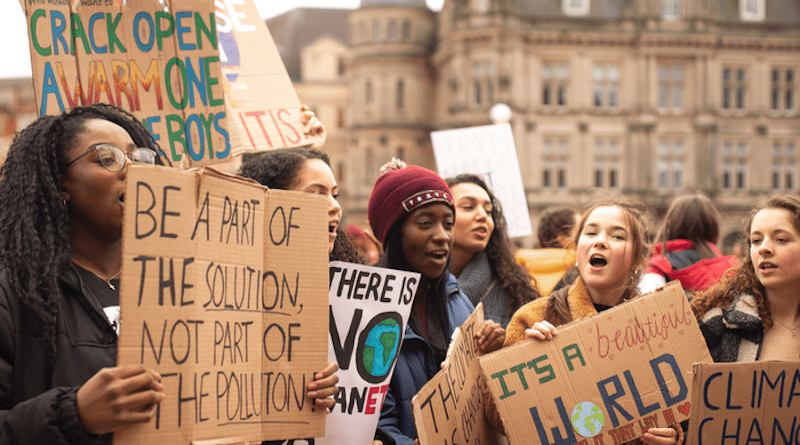Is It Worth Trying To Sway Most Staunch Climate Deniers?
Thanks to algorithms that learn about social media users’ content preferences, Facebook timelines, Twitter feeds, suggested YouTube videos, and other news streams can look startlingly different from one person’s online account to the next. Media and communication experts often wrestle with how to rein in the forces that further polarize people with different views, especially people who sit on opposite sides of the political aisle. When it comes to online content that contains disinformation—inaccurate messages or propaganda intended to deceive and influence readers—why are some people more likely to believe falsehoods often spread via social media and the internet?
Arunima Krishna, a Boston University College of Communication researcher who studies public perceptions of controversial social issues, is studying the spread of disinformation, specifically related to climate science—an issue that has been manipulated by climate change deniers for decades. In her latest study, Krishna surveyed 645 Americans about their beliefs on climate change—whether or not those beliefs are informed by fact or fiction—to assess their communication behaviors about climate change.
“I think a lot of folks don’t see how close to home climate change is. Even though we’re seeing climate refugees, [worsening] hurricanes, and other [natural] disasters, there is still a level of distance from the problem,” says Krishna, a College of Communication assistant professor of public relations.
She points out that physical distance from the effects of climate change could be partly why some people find it is easier to separate themselves from the climate crisis. Plus, climate solutions are often things many people don’t readily want to do, like eating less meat, using less plastic, and buying less material goods. Fossil fuel companies and lobbyists for the industry have also worked extremely hard to deceive the public from knowing the full extent of the damaging impact of burning fossil fuels, she says.
According to Krishna’s survey of Americans, 7 in 10 people who are susceptible to believing climate disinformation self-identified as politically conservative. In contrast, 8 in 10 Americans who self-identified as liberal were found to be immune to disinformation about climate change. Those findings double down on past research from the Yale Program on Climate Change Communication, which found liberals and Democrats are significantly more worried about climate change than conservatives and Republicans, and are more likely to believe humans are causing the climate crisis.
Krishna also detected a difference in age between those who were more susceptible to disinformation and those who weren’t. More than half of the respondents immune to false information about climate were under 45. Those more receptive to climate disinformation were, on average, over the age of 46.
Diving deeper into the respondents’ responses, Krishna categorized the survey results into four different groups. The first segment, made up of people she calls the “disinformation immune,” have not accepted any disinformation about climate change and humans’ role in it, and they likely never will. The second group, the“disinformation vulnerable,” have negative attitudes about how humans are influencing climate. While they haven’t yet accepted disinformation, some of their responses to facts about climate change—as well as their attitudes and motivations—indicate they could possibly believe climate disinformation in the future. The third group, the “disinformation receptive,” have accepted false information about climate change already. Lastly, the fourth group, the “disinformation amplifying,” is made up of people who hold extremely negative attitudes about climate change and doubt humans’ role in accelerating it, have already accepted disinformation, and are highly motivated to spread the disinformation they believe.
“My study found that [disinformation amplifiers] are more likely to spread their opinions about climate change compared to everybody else in the survey,” Krishna says. The amplifiers are known as what Krishna calls “lacuna publics,” a term she coined in 2017 when she was researching vaccine hesitant groups. (The word “publics” refers to groups connected by issue-specific motivation, and “lacuna” means a gap in knowledge.) Though the disinformation amplifiers, or lacuna publics, are in the minority, they are different from groups that are disinformation vulnerable or receptive because of their willingness to spread disinformation.
The United States has more climate skeptics than anywhere else in the world, Krishna says, but their ranks have started to shrink. Climate scientists around the world have found unequivocally that the more we continue to emit heat-trapping greenhouse gases into the atmosphere, the worse the consequences will be for humans, most species, and ecosystems on Earth.
Though there is no single solution to stopping the spread of climate disinformation, Krishna emphasizes the importance of engaging with people most vulnerable to believing disinformation. Lacuna publics, or amplifiers, however, might be difficult or impossible to sway.
“It might not be worth using resources to try to reach the lacuna publics,” Krishna says. “Research tells us that one-on-one interaction can often be more effective than mass media messages…so perhaps that’s the best way to [elevate] voices who are disinformation immune.”

